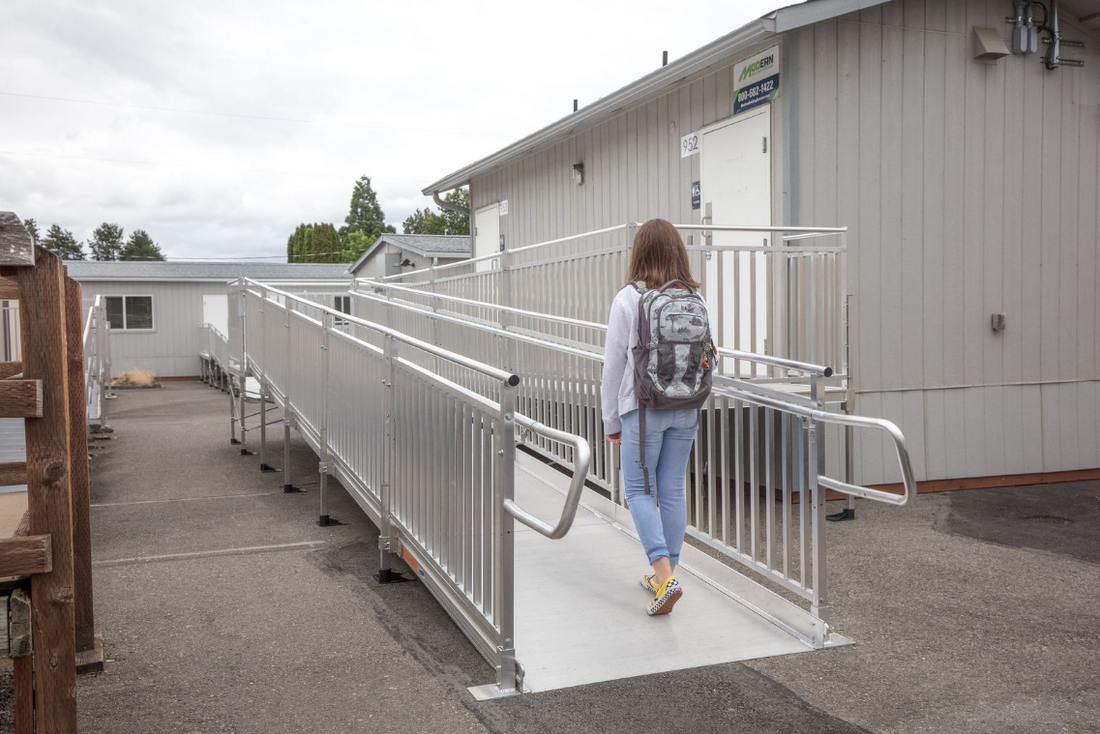Creating an accessible environment in schools is not just a legal obligation—it's a commitment to inclusivity and equal opportunity for all students, staff, and visitors. The Americans with Disabilities Act (ADA) sets forth requirements to ensure that public and private schools are accessible to individuals with disabilities. To help you navigate these requirements, we've compiled a comprehensive checklist to ensure your school is ADA compliant.
1. Accessible Entrances and Exits
- Ramps and Handrails: Ensure that all main entrances have ramps with handrails, providing an accessible route for individuals who use wheelchairs or have mobility impairments.
- Doorways: Doorways should be at least 32 inches wide to accommodate wheelchairs. Automatic doors or doors with lever handles are recommended for ease of use.
- Signage: Place clear, large-print, and Braille signage at all entrances and exits to guide individuals with visual impairments.
2. Accessible Classrooms
- Desks and Seating: Provide adjustable-height desks and tables to accommodate students who use wheelchairs. Ensure that there is enough space for maneuvering and that seating arrangements consider accessibility.
- Technology: Equip classrooms with accessible technology, such as screen readers, voice recognition software, and assistive listening devices, to support students with disabilities.
- Lighting: Ensure classrooms are well-lit, with adjustable lighting options to accommodate students with visual impairments or sensory sensitivities.
3. Restrooms
- Accessible Stalls: Restrooms should have at least one accessible stall with grab bars and enough space for a wheelchair to turn around.
- Sinks and Faucets: Install sinks at an accessible height with lever-operated faucets. Ensure soap dispensers and hand dryers are within reach.
- Signage: Clear, large-print, and Braille signage should indicate the location of accessible restrooms.
4. Common Areas and Playgrounds
- Cafeterias and Auditoriums: Ensure that common areas like cafeterias and auditoriums have accessible seating options and clear pathways. Consider providing wheelchair-accessible tables and seating in multiple locations.
- Playgrounds: Play areas should include equipment accessible to children with disabilities, such as ramps to elevated play structures, swings with harnesses, and ground-level play components.
- Paths of Travel: Ensure that all paths of travel, including sidewalks and walkways, are wide enough for wheelchair access and are free of obstructions.
5. Accessible Parking and Transportation
- Parking Spaces: Provide designated accessible parking spaces close to school entrances. These spaces should be clearly marked and have ample room for wheelchair access.
- Drop-off and Pick-up Areas: Ensure that drop-off and pick-up areas are accessible, with curb cuts and ramps where necessary.
- School Buses: If your school provides transportation, ensure that buses are equipped with lifts or ramps and that drivers are trained in assisting students with disabilities.
6. Emergency Preparedness
- Evacuation Plans: Develop and practice evacuation plans that include provisions for students, staff, and visitors with disabilities. This may involve assigning specific staff to assist individuals during an emergency.
- Alarm Systems: Install visual and auditory alarm systems to alert individuals with hearing or visual impairments in case of an emergency.
- Safe Areas: Designate safe areas where individuals with disabilities can wait for assistance during an evacuation.
7. Staff Training
- Awareness and Sensitivity Training: Provide ongoing training for staff on ADA requirements, as well as sensitivity training to ensure that all staff understand the needs of students with disabilities.
- Use of Assistive Devices: Train staff on the use of assistive devices and technology to better support students with disabilities.
- Emergency Procedures: Ensure that all staff are familiar with emergency procedures that accommodate individuals with disabilities.
8. Ongoing Evaluation and Improvement
- Regular Audits: Conduct regular accessibility audits to identify areas for improvement. This can involve reviewing facilities, programs, and services to ensure continued compliance with ADA standards.
- Feedback from the Community: Engage with students, parents, and staff to gather feedback on accessibility. This feedback can provide valuable insights into areas that may need attention or improvement.
- Staying Updated: Keep up with any changes in ADA regulations and ensure your school’s policies and practices are updated accordingly.
Ensuring ADA compliance in schools is about more than just following the law—it's about creating a supportive and inclusive environment where every student can thrive. By following this comprehensive checklist, schools can make significant strides in accessibility and inclusivity.
Ready to enhance accessibility at your school? Contact EZ-ACCESS® today to discuss customized solutions that meet your unique needs. Whether you need ramps, raised platforms, or other access solutions, we’re here to help you create a safe, inclusive environment for all. Get in touch with us now to get started!

